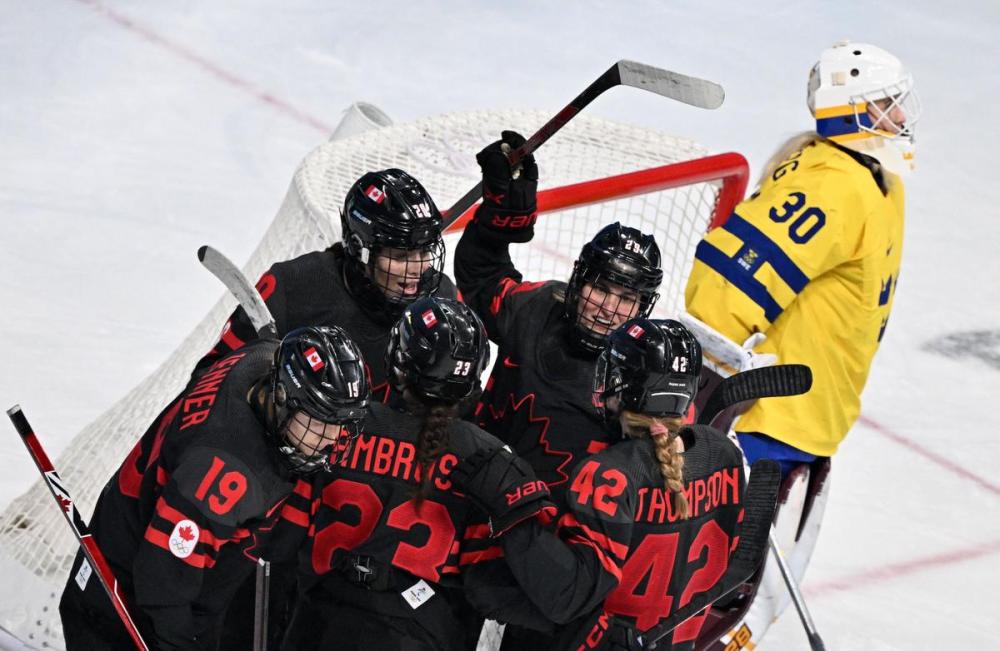How do you improve an already dominant Canadian women’s hockey team? You get creative
Advertisement
Read this article for free:
or
Already have an account? Log in here »
To continue reading, please subscribe:
Monthly Digital Subscription
$0 for the first 4 weeks*
- Enjoy unlimited reading on winnipegfreepress.com
- Read the E-Edition, our digital replica newspaper
- Access News Break, our award-winning app
- Play interactive puzzles
*No charge for 4 weeks then price increases to the regular rate of $19.00 plus GST every four weeks. Offer available to new and qualified returning subscribers only. Cancel any time.
Monthly Digital Subscription
$4.75/week*
- Enjoy unlimited reading on winnipegfreepress.com
- Read the E-Edition, our digital replica newspaper
- Access News Break, our award-winning app
- Play interactive puzzles
*Billed as $19 plus GST every four weeks. Cancel any time.
To continue reading, please subscribe:
Add Free Press access to your Brandon Sun subscription for only an additional
$1 for the first 4 weeks*
*Your next subscription payment will increase by $1.00 and you will be charged $16.99 plus GST for four weeks. After four weeks, your payment will increase to $23.99 plus GST every four weeks.
Read unlimited articles for free today:
or
Already have an account? Log in here »
Hey there, time traveller!
This article was published 11/02/2022 (1397 days ago), so information in it may no longer be current.
BEIJING Frankly, it was hard to find mistakes. In a lopsided Olympic women’s hockey quarterfinal, Sweden wore their peerless yellow uniforms, and Canada often made them like canaries trying to fight off hawks.
But after that 11-0 win, veteran defender Jocelyne Larocque said that for all the skill and speed and size and determination, trying to get better is the engine of this team. And that came with a different way to think about themselves, too.
“What I think drives it is the openness to try new things, and we don’t have any fear of making mistakes,” Larocque said. “In the past, I think we were a little bit fearful of making mistakes, and honestly, this environment that (head coach) Troy Ryan, our coaches, (GM) Gina Kingsbury have set out, it’s an environment where people can be creative, within structure, but people aren’t scared to make mistakes.

“It’s a huge change in our culture and our program, and it’s really exciting to be a part of.”
You can pick your favourite way to spell out the way things went Friday. Canada dominated possession while on the penalty kill. Brianne Jenner scored Canada’s opening goal, the first of her three, though in fairness she was subsequently stopped on a 2-on-0 by Swedish goalie Emma Soderberg. Twenty-one-year-old Sarah Fillier scored two goals in 36 seconds and, after finishing with a hat trick, has matched Jenner with a tournament-high eight goals, all in her first 15 Olympic periods of play. Uh, pretty good. At one point Canada scored eight goals in 12:04 of game time.
Meanwhile, the U.S., which had outshot Canada in its head-to-head matchup and lost, also had trouble finishing in a 4-1 quarterfinal win over the Olympic rookie Czechs. That game was tied 1-1 headed to the third period. Canada did something else.
Larocque said one reason Canada’s offence has been such a tidal wave — Canada has outscored Switzerland, Finland, Russia, the U.S. and now Sweden 44-5 in five games — was that nobody was gripping their sticks too tightly. Ryan said the team’s leadership decided last year to tip in that direction, which is hockey’s most essential philosophical debate: more offence or more defence, with defence winning more of the time. Canada plays ruthless and relentless defensive hockey, and that hasn’t changed. But freedom to try stuff is not always welcome in the sport of one-goal games.
“One of the things we tried to talk about early on is, to make this team, you had to be willing to make mistakes,” Ryan said. “You had to be willing to add to your game. It’s always an evaluation process at this level, and every time they come together, how do you get better if you don’t open yourself up a little bit? So we just tried to create that.”
The fear of mistakes for a program trying to play perfect hockey is perhaps understandable. Every big game against the U.S. is a one-goal monster.
“I think it was maybe pressure,” Larocque said. “Honestly, I think in the past, we maybe put too much pressure on ourselves, and maybe the games against the U.S., we made them bigger than what they are. And not that they’re not big. But it’s that your approach and your mentality need to say the same, game in, game out.”
It’s not the 1980s Oilers, and drat the luck. And maybe in a gold-medal game it’s rebound goals and Fillier and Marie-Philip Poulin that make the difference. But it’s something. Ryan didn’t take credit for the offence: after all, in the pandemic every nation’s players played themselves, which might also have something to do with this. The Swedes, when possible in an underfunded program, played the Swedes. Canadians played Canadians. You get better that way. They were already great.
Now they are a game away from the gold-medal game, facing either Russia (if Finland beats Japan in the last quarterfinal) or Japan (if Japan wins), and the goals could keep coming in their semifinal.
“I think, when you really look at the way we play, we got a lot of talented players that can play offence,” Ryan said. “And when they start a little bit more working as a group, those creative plays tend to unfold.”
Yes. It’s progress. But it’s Canada, too.
Bruce Arthur is a Toronto-based columnist for the Star. Follow him on Twitter: @bruce_arthur








